Association Between Neutrophil-to-HDL Ratio and Full-Spectrum Dysglycemia: Insights from a Large Middle Eastern Population Study
Abstract
1. Introduction
2. Materials and Methods
2.1. Study Population and Design
2.2. Statistics
3. Results
3.1. Baseline Characteristics of the Study Population
3.2. NHR Levels Are Elevated in Dysglycemia and Associated with Higher FBG
3.3. Age- and Gender-Stratified Analysis of NHR in Dysglycemia
3.4. Correlation of NHR with FBG Concentration in the Study Population
3.5. Diagnostic Performance of NHR for Dysglycemia in Light of FBG Concentrations
3.6. Evaluating NHR Patterns Across HbA1c Ranges
3.7. NHR Shows Stronger Correlation with HbA1c than CRP
3.8. Diagnostic Performance of NHR for Dysglycemia in Relation to HbA1c
3.9. Elevated NHR Levels Are More Prevalent Among Dysglycemic Subjects
3.10. Risk Assessment Analysis of the Association Between NHR and Dysglycemia Forms
3.11. Regression Analysis of the Association Between NHR and Glycemic Markers
4. Discussion
5. Conclusions
Author Contributions
Funding
Institutional Review Board Statement
Informed Consent Statement
Data Availability Statement
Acknowledgments
Conflicts of Interest
References
- Wu, Y.; Ding, Y.; Tanaka, Y.; Zhang, W. Risk Factors Contributing to Type 2 Diabetes and Recent Advances in the Treatment and Prevention. Int. J. Med. Sci. 2014, 11, 1185. [Google Scholar] [CrossRef]
- Long, A.N.; Dagogo-Jack, S. Comorbidities of Diabetes and Hypertension: Mechanisms and Approach to Target Organ Protection. J. Clin. Hypertens. 2011, 13, 244–251. [Google Scholar] [CrossRef]
- Sjöholm, Å. Prediabetic Dysglycemia: Call for Action. Curr. Diabetes Rev. 2020, 17, 21–25. [Google Scholar] [CrossRef]
- 8th Edition | IDF Diabetes Atlas. Available online: https://diabetesatlas.org/ (accessed on 12 April 2024).
- Saeedi, P.; Petersohn, I.; Salpea, P.; Malanda, B.; Karuranga, S.; Unwin, N.; Colagiuri, S.; Guariguata, L.; Motala, A.A.; Ogurtsova, K.; et al. Global and Regional Diabetes Prevalence Estimates for 2019 and Projections for 2030 and 2045: Results from the International Diabetes Federation Diabetes Atlas, 9th Edition. Diabetes Res. Clin. Pract. 2019, 157, 107843. [Google Scholar] [CrossRef]
- Alqahtani, B.; Elnaggar, R.K.; Alshehri, M.M.; Khunti, K.; Alenazi, A. National and Regional Prevalence Rates of Diabetes in Saudi Arabia: Analysis of National Survey Data. Int. J. Diabetes Dev. Ctries. 2022, 43, 392–397. [Google Scholar] [CrossRef]
- Jarrar, M.; Abusalah, M.H.; Albaker, W.; Al-Bsheish, M.; Alsyouf, A.; Al-Mugheed, K.; Issa, M.; Alumran, A. Prevalence of Type 2 Diabetes Mellitus in the General Population of Saudi Arabia, 2000-2020: A Systematic Review and Meta-Analysis of Observational Studies. Saudi J. Med. Med. Sci. 2023, 11, 1–10. [Google Scholar] [CrossRef]
- Alwadeai, K.S.; Alhammad, S.A. Prevalence of Type 2 Diabetes Mellitus and Related Factors among the General Adult Population in Saudi Arabia between 2016–2022: A Systematic Review and Meta-Analysis of the Cross-Sectional Studies. Medicine 2023, 102, E34021. [Google Scholar] [CrossRef]
- Mokdad, A.H.; Tuffaha, M.; Hanlon, M.; El Bcheraoui, C.; Daoud, F.; Al Saeedi, M.; Alrasheedy, A.A.; Al Hussein, M.A.; Memish, Z.A.; Basulaiman, M.; et al. Cost of Diabetes in the Kingdom of Saudi Arabia. J. Diabetes Metab. 2015, 6, 575. [Google Scholar] [CrossRef]
- Tsalamandris, S.; Antonopoulos, A.S.; Oikonomou, E.; Papamikroulis, G.A.; Vogiatzi, G.; Papaioannou, S.; Deftereos, S.; Tousoulis, D. The Role of Inflammation in Diabetes: Current Concepts and Future Perspectives. Eur. Cardiol. Rev. 2019, 14, 50. [Google Scholar] [CrossRef]
- Cooke, J.P. Asymmetrical Dimethylarginine: The Uber Marker? Circulation 2004, 109, 1813–1819. [Google Scholar] [CrossRef]
- Hong, N.; Lin, Y.; Ye, Z.; Yang, C.; Huang, Y.; Duan, Q.; Xie, S. The Relationship between Dyslipidemia and Inflammation among Adults in East Coast China: A Cross-Sectional Study. Front. Immunol. 2022, 13, 937201. [Google Scholar] [CrossRef]
- Yaw, H.P.; Devi, S.; Ng, L.G. Neutrophils: Key Players in the Metabolic Syndrome Puzzle. hLife 2025, 3, 121–131. [Google Scholar] [CrossRef]
- Nazir, S.; Jankowski, V.; Bender, G.; Zewinger, S.; Rye, K.A.; van der Vorst, E.P.C. Interaction between High-Density Lipoproteins and Inflammation: Function Matters More than Concentration! Adv. Drug Deliv. Rev. 2020, 159, 94–119. [Google Scholar] [CrossRef]
- Jiang, M.; Sun, J.; Zou, H.; Li, M.; Su, Z.; Sun, W.; Kong, X. Prognostic Role of Neutrophil to High-Density Lipoprotein Cholesterol Ratio for All-Cause and Cardiovascular Mortality in the General Population. Front. Cardiovasc. Med. 2022, 9, 807339. [Google Scholar] [CrossRef]
- Shi, K.; Hou, J.; Zhang, Q.; Bi, Y.; Zeng, X.; Wang, X. Neutrophil-to-High-Density-Lipoprotein-Cholesterol Ratio and Mortality among Patients with Hepatocellular Carcinoma. Front Nutr. 2023, 10, 1127913. [Google Scholar] [CrossRef]
- Yu, L.; Ma, K.; Hao, J.; Zhang, B. Neutrophil to High-Density Lipoprotein Cholesterol Ratio, a Novel Risk Factor Associated with Acute Ischemic Stroke. Medicine 2023, 102, E34173. [Google Scholar] [CrossRef]
- Alfhili, M.A.; Alsughayyir, J.; Basudan, A.; Ghneim, H.K.; Aboul-Soud, M.A.M.; Marie, M.; Dera, A.; Alfaifi, M.; Alkhathami, A.G.; Awan, Z.A.; et al. Isolated and Combined Effect of Age and Gender on Neutrophil-Lymphocyte Ratio in the Hyperglycemic Saudi Population. Medicina 2022, 58, 1040. [Google Scholar] [CrossRef]
- Association, A.D. Standards of Medical Care in Diabetes—2014. Diabetes Care 2014, 37, S14–S80. [Google Scholar] [CrossRef]
- Wang, Y.; Zhang, J.; Li, H.; Kong, W.; Zheng, J.; Li, Y.; Wei, Q.; Li, Q.; Yang, L.; Xu, Y.; et al. Prognostic Value of Leucocyte to High-Density Lipoprotein-Cholesterol Ratios in COVID-19 Patients and the Diabetes Subgroup. Front. Endocrinol. 2021, 12, 727419. [Google Scholar] [CrossRef]
- Chen, L.L.; Mao, W.L.; Yuan, M.C.; He, X. Relationship between Neutrophil-to-HDL Cholesterol Ratio and Mortality in Hospitalized HBV-Associated Decompensated Cirrhosis. Clin. Lab. 2023, 69, 1955–1961. [Google Scholar] [CrossRef]
- Huang, J.B.; Chen, Y.S.; Ji, H.Y.; Xie, W.M.; Jiang, J.; Ran, L.S.; Zhang, C.T.; Quan, X.Q. Neutrophil to High-Density Lipoprotein Ratio Has a Superior Prognostic Value in Elderly Patients with Acute Myocardial Infarction: A Comparison Study. Lipids Health Dis. 2020, 19, 59. [Google Scholar] [CrossRef]
- Liu, S.L.; Feng, B.Y.; Song, Q.R.; Zhang, Y.M.; Wu, S.L.; Cai, J. Neutrophil to High-Density Lipoprotein Cholesterol Ratio Predicts Adverse Cardiovascular Outcomes in Subjects with Pre-Diabetes: A Large Cohort Study from China. Lipids Health Dis. 2022, 21, 86. [Google Scholar] [CrossRef]
- Yu, Q.; Weng, W.; Luo, H.; Yan, J.; Zhao, X. The Novel Predictive Biomarkers for Type 2 Diabetes Mellitus in Active Pulmonary Tuberculosis Patients. Infect. Drug Resist. 2022, 15, 4529. [Google Scholar] [CrossRef]
- Ren, H.; Zhu, B.; Zhao, Z.; Li, Y.; Deng, G.; Wang, Z.; Ma, B.; Feng, Y.; Zhang, Z.; Zhao, X.; et al. Neutrophil to High-Density Lipoprotein Cholesterol Ratio as the Risk Mark in Patients with Type 2 Diabetes Combined with Acute Coronary Syndrome: A Cross-Sectional Study. Sci. Rep. 2023, 13, 7836. [Google Scholar] [CrossRef]
- Tao, Y.; Liu, Y.; Guo, S.; Dong, C. Association between Neutrophil-to-High-Density Lipoprotein-Cholesterol Ratio and Prevalence and Mortality of Diabetes: A Cross-Sectional Study. BMC Endocr. Disord. 2025, 25, 163. [Google Scholar] [CrossRef]
- Chen, Z.; Li, Y.; Zhu, X. Positive Association Between the Ratio of Neutrophil to High-Density Lipoprotein Cholesterol and Diabetes Incidence: A Retrospective Cohort Study. J. Inflamm. Res. 2025, 18, 11373–11384. [Google Scholar] [CrossRef]
- Chen, T.; Chen, H.; Xiao, H.; Tang, H.; Xiang, Z.; Wang, X.; Wang, X.; Zou, H. Comparison of the Value of Neutrophil to High-Density Lipoprotein Cholesterol Ratio and Lymphocyte to High-Density Lipoprotein Cholesterol Ratio for Predicting Metabolic Syndrome Among a Population in the Southern Coast of China. Diabetes Metab. Syndr. Obes. 2020, 13, 597–605. [Google Scholar] [CrossRef]
- Twig, G.; Afek, A.; Shamiss, A.; Derazne, E.; Tzur, D.; Gordon, B.; Tirosh, A. White Blood Cells Count and Incidence of Type 2 Diabetes in Young Men. Diabetes Care 2013, 36, 276–282. [Google Scholar] [CrossRef]
- Vozarova, B.; Weyer, C.; Lindsay, R.S.; Pratley, R.E.; Bogardus, C.; Antonio Tataranni, P. High White Blood Cell Count Is Associated with a Worsening of Insulin Sensitivity and Predicts the Development of Type 2 Diabetes. Diabetes 2002, 51, 455–461. [Google Scholar] [CrossRef]
- Ohshita, K.; Yamane, K.; Hanafusa, M.; Mori, H.; Mito, K.; Okubo, M.; Hara, H.; Kohno, N. Elevated White Blood Cell Count in Subjects with Impaired Glucose Tolerance. Diabetes Care 2004, 27, 491–496. [Google Scholar] [CrossRef]
- Zang, X.; Meng, X.; Wang, Y.; Jin, X.; Wu, T.; Liu, X.; Geng, H.; Xu, W.; Wang, Y.; Teng, F.; et al. Six-year Follow-up Study on the Association between White Blood Cell Count and Fasting Blood Glucose Level in Chinese Adults: A Community-based Health Examination Survey. Diabetes Metab Res. Rev. 2019, 35, e3125. [Google Scholar] [CrossRef]
- Kannel, W.B.; Anderson, K.; Wilson, P.W.F. White Blood Cell Count and Cardiovascular Disease: Insights From the Framingham Study. JAMA 1992, 267, 1253–1256. [Google Scholar] [CrossRef]
- Schmidt, M.I.; Duncan, B.B.; Sharrett, A.R.; Lindberg, G.; Savage, P.J.; Offenbacher, S.; Azambuja, M.I.; Tracy, R.P.; Heiss, G. Markers of Inflammation and Prediction of Diabetes Mellitus in Adults (Atherosclerosis Risk in Communities Study): A Cohort Study. Lancet 1999, 353, 1649–1652. [Google Scholar] [CrossRef]
- Woo, S.J.; Ahn, S.J.; Ahn, J.; Park, K.H.; Lee, K. Elevated Systemic Neutrophil Count in Diabetic Retinopathy and Diabetes: A Hospital-Based Cross-Sectional Study of 30,793 Korean Subjects. Invest. Ophthalmol. Vis. Sci. 2011, 52, 7697–7703. [Google Scholar] [CrossRef]
- He, J.; Lin, Z.; Song, C.; Zhang, R.; Wang, H.; Yuan, S.; Bian, X.; Dong, Q.; Dou, K. High Absolute Neutrophil Count with Type 2 Diabetes Is Associated with Adverse Outcome in Patients with Coronary Artery Disease: A Large-Scale Cohort Study. Front Endocrinol 2023, 14, 1129633. [Google Scholar] [CrossRef] [PubMed]
- He, J.; Bian, X.; Song, C.; Zhang, R.; Yuan, S.; Yin, D.; Dou, K. High Neutrophil to Lymphocyte Ratio with Type 2 Diabetes Mellitus Predicts Poor Prognosis in Patients Undergoing Percutaneous Coronary Intervention: A Large-Scale Cohort Study. Cardiovasc. Diabetol. 2022, 21, 156. [Google Scholar] [CrossRef]
- Wang, L.; Pan, J.; Sun, Y.; Zong, S.; Zhang, R.; Li, Y.; Yu, Z.; Liu, J.; Zang, S. Increased Neutrophil Elastase and Proteinase 3 Are Closely Associated with Occurrence and Severity of Stroke and Acute Myocardial Infarction in Patients with Type 2 Diabetes Mellitus. Diabetes Res. Clin. Pr. 2022, 186, 109853. [Google Scholar] [CrossRef] [PubMed]
- Lin, Q.; Zhou, W.; Wang, Y.; Huang, J.; Hui, X.; Zhou, Z.; Xiao, Y. Abnormal Peripheral Neutrophil Transcriptome in Newly Diagnosed Type 2 Diabetes Patients. J. Diabetes Res. 2020, 2020, 9519072. [Google Scholar] [CrossRef]
- Gough, N.R. Neutrophils Suppress Insulin Signaling. Sci. Signal. 2012, 5, ec250. [Google Scholar] [CrossRef]
- Hanses, F.; Park, S.; Rich, J.; Lee, J.C. Reduced Neutrophil Apoptosis in Diabetic Mice during Staphylococcal Infection Leads to Prolonged Tnfα Production and Reduced Neutrophil Clearance. PLoS ONE 2011, 6, 23633. [Google Scholar] [CrossRef]
- Talukdar, S.; Oh, D.Y.; Bandyopadhyay, G.; Li, D.; Xu, J.; McNelis, J.; Lu, M.; Li, P.; Yan, Q.; Zhu, Y.; et al. Neutrophils Mediate Insulin Resistance in Mice Fed a High-Fat Diet through Secreted Elastase. Nat. Med. 2012, 18, 1407–1412. [Google Scholar] [CrossRef]
- Dowey, R.; Iqbal, A.; Heller, S.R.; Sabroe, I.; Prince, L.R. A Bittersweet Response to Infection in Diabetes; Targeting Neutrophils to Modify Inflammation and Improve Host Immunity. Front. Immunol. 2021, 12, 678771. [Google Scholar] [CrossRef] [PubMed]
- Stefano, G.B.; Challenger, S.; Kream, R.M. Hyperglycemia-Associated Alterations in Cellular Signaling and Dysregulated Mitochondrial Bioenergetics in Human Metabolic Disorders. Eur. J. Nutr. 2016, 55, 2339. [Google Scholar] [CrossRef] [PubMed]
- Thimmappa, P.Y.; Vasishta, S.; Ganesh, K.; Nair, A.S.; Joshi, M.B. Neutrophil (Dys)Function Due to Altered Immuno-Metabolic Axis in Type 2 Diabetes: Implications in Combating Infections. Hum. Cell 2023, 36, 1265. [Google Scholar] [CrossRef]
- Wu, L.; Parhofer, K.G. Diabetic Dyslipidemia. Metabolism 2014, 63, 1469–1479. [Google Scholar] [CrossRef]
- Goldberg, I.J. Clinical Review 124: Diabetic Dyslipidemia: Causes and Consequences. J. Clin. Endocrinol. Metab. 2001, 86, 965–971. [Google Scholar] [CrossRef]
- Gluba-Brzózka, A.; Rysz, J.; Franczyk, B.; Banach, M. Dyslipidemia in Patients with Diabetes. In Diabetes and Kidney Disease, 2nd ed.; Springer: Berlin/Heidelberg, Germany, 2023; pp. 341–360. [Google Scholar] [CrossRef]
- Lui, D.T.W.; Li, L.; Liu, X.; Xiong, X.; Tang, E.H.M.; Lee, C.H.; Woo, Y.C.; Lang, B.H.H.; Wong, C.K.H.; Tan, K.C.B. The Association of HDL-Cholesterol Levels with Incident Major Adverse Cardiovascular Events and Mortality in 0.6 Million Individuals with Type 2 Diabetes: A Population-Based Retrospective Cohort Study. BMC Med. 2024, 22, 586. [Google Scholar] [CrossRef] [PubMed]
- Lee, J.S.; Chang, P.Y.; Zhang, Y.; Kizer, J.R.; Best, L.G.; Howard, B.V. Triglyceride and HDL-C Dyslipidemia and Risks of Coronary Heart Disease and Ischemic Stroke by Glycemic Dysregulation Status: The Strong Heart Study. Diabetes Care 2017, 40, 529–537. [Google Scholar] [CrossRef]
- Dejenie, T.A.; Abebe, E.C.; Mengstie, M.A.; Seid, M.A.; Gebeyehu, N.A.; Adella, G.A.; Kassie, G.A.; Gebrekidan, A.Y.; Gesese, M.M.; Tegegne, K.D.; et al. Dyslipidemia and Serum Cystatin C Levels as Biomarker of Diabetic Nephropathy in Patients with Type 2 Diabetes Mellitus. Front. Endocrinol. 2023, 14, 1124367. [Google Scholar] [CrossRef]
- Hager, M.R.; Narla, A.D.; Tannock, L.R. Dyslipidemia in Patients with Chronic Kidney Disease. Rev. Endocr. Metab. Disord. 2017, 18, 29–40. [Google Scholar] [CrossRef]
- Opazo-Ríos, L.; Mas, S.; Marín-Royo, G.; Mezzano, S.; Gómez-Guerrero, C.; Moreno, J.A.; Egido, J. Molecular Sciences Lipotoxicity and Diabetic Nephropathy: Novel Mechanistic Insights and Therapeutic Opportunities. Int. J. Mol. Sci. 2020, 21, 2632. [Google Scholar] [CrossRef] [PubMed]
- Drew, B.G.; Duffy, S.J.; Formosa, M.F.; Natoli, A.K.; Henstridge, D.C.; Penfold, S.A.; Thomas, W.G.; Mukhamedova, N.; De Courten, B.; Forbes, J.M.; et al. High-Density Lipoprotein Modulates Glucose Metabolism in Patients with Type 2 Diabetes Mellitus. Circulation 2009, 119, 2103–2111. [Google Scholar] [CrossRef] [PubMed]
- Fryirs, M.A.; Barter, P.J.; Appavoo, M.; Tuch, B.E.; Tabet, F.; Heather, A.K.; Rye, K.A. Effects of High-Density Lipoproteins on Pancreatic Beta-Cell Insulin Secretion. Arter. Thromb. Vasc. Biol. 2010, 30, 1642–1648. [Google Scholar] [CrossRef]
- Hussein, O.A.; Gefen, Y.; Zidan, J.M.; Karochero, E.Y.; Luder, A.S.; Assy, N.N.; Sror, E.S.; Aviram, M.Y. LDL Oxidation Is Associated with Increased Blood Hemoglobin A1c Levels in Diabetic Patients. Clin. Chim. Acta 2007, 377, 114–118. [Google Scholar] [CrossRef]
- Poznyak, A.V.; Sukhorukov, V.N.; Surkova, R.; Orekhov, N.A.; Orekhov, A.N. Glycation of LDL: AGEs, Impact on Lipoprotein Function, and Involvement in Atherosclerosis. Front. Cardiovasc. Med. 2023, 10, 1094188. [Google Scholar] [CrossRef]
- Klimov, A.N.; Kozhevnikova, K.A.; Kuzmin, A.A.; Kuznetsov, A.S.; Belova, E.V. On the Ability of High Density Lipoproteins to Remove Phospholipid Peroxidation Products from Erythrocyte Membranes. Biochemistry 2001, 66, 300–304. [Google Scholar] [CrossRef]
- Boisfer, E.; Stengel, D.; Pastier, D.; Michel Laplaud, P.; Dousset, N.; Ninio, E.; Kalopissis, A.D. Antioxidant Properties of HDL in Transgenic Mice Overexpressing Human Apolipoprotein A-II. J. Lipid Res. 2002, 43, 732–741. [Google Scholar] [CrossRef] [PubMed]
- Filou, S.; Lhomme, M.; Karavia, E.A.; Kalogeropoulou, C.; Theodoropoulos, V.; Zvintzou, E.; Sakellaropoulos, G.C.; Petropoulou, P.I.; Constantinou, C.; Kontush, A.; et al. Distinct Roles of Apolipoproteins A1 and e in the Modulation of High-Density Lipoprotein Composition and Function. Biochemistry 2016, 55, 3752–3762. [Google Scholar] [CrossRef]
- Elsøe, S.; Ahnström, J.; Christoffersen, C.; Hoofnagle, A.N.; Plomgaard, P.; Heinecke, J.W.; Binder, C.J.; Björkbacka, H.; Dahlbäck, B.; Nielsen, L.B. Apolipoprotein M Binds Oxidized Phospholipids and Increases the Antioxidant Effect of HDL. Atherosclerosis 2012, 221, 91–97. [Google Scholar] [CrossRef]
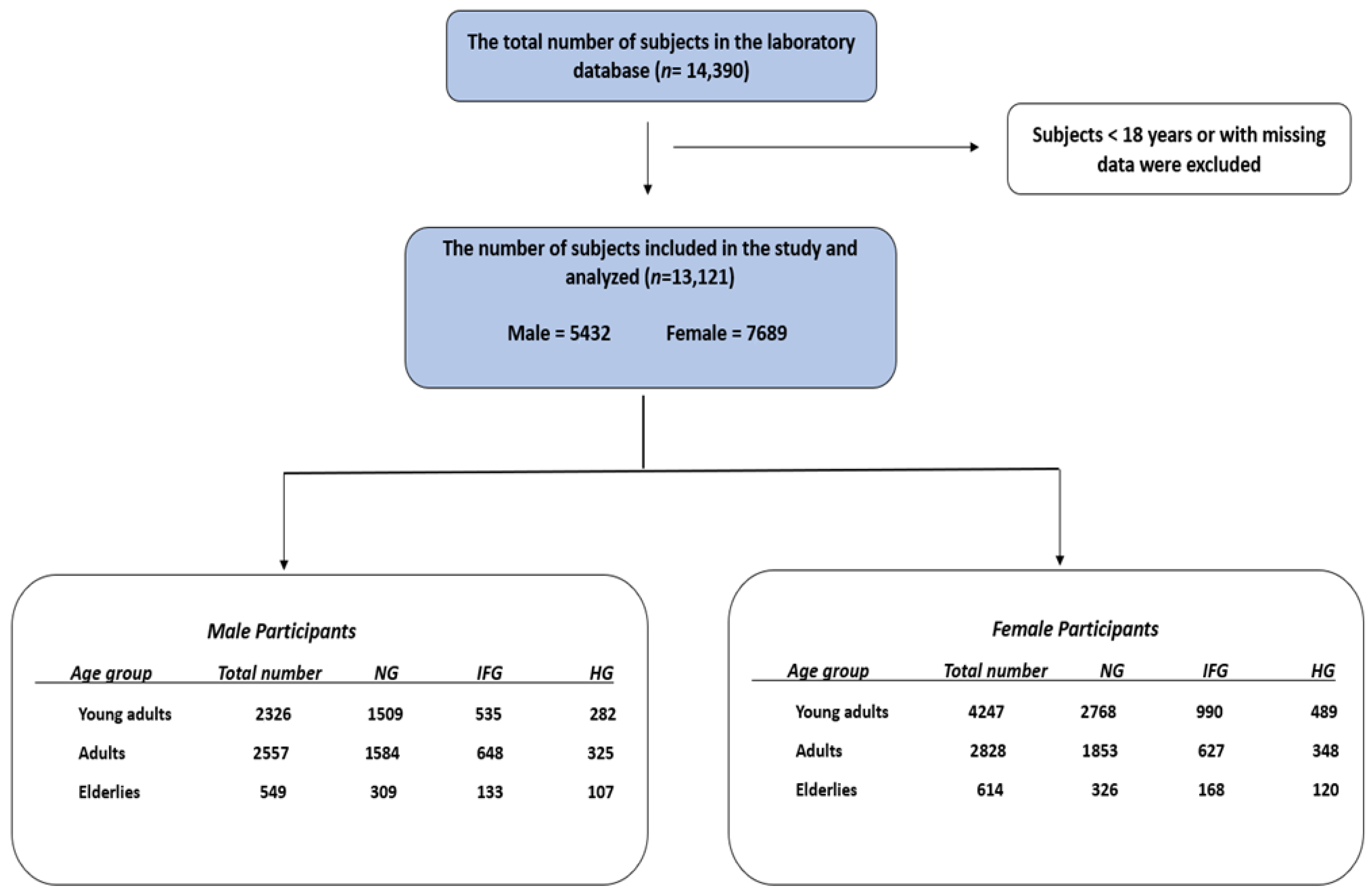
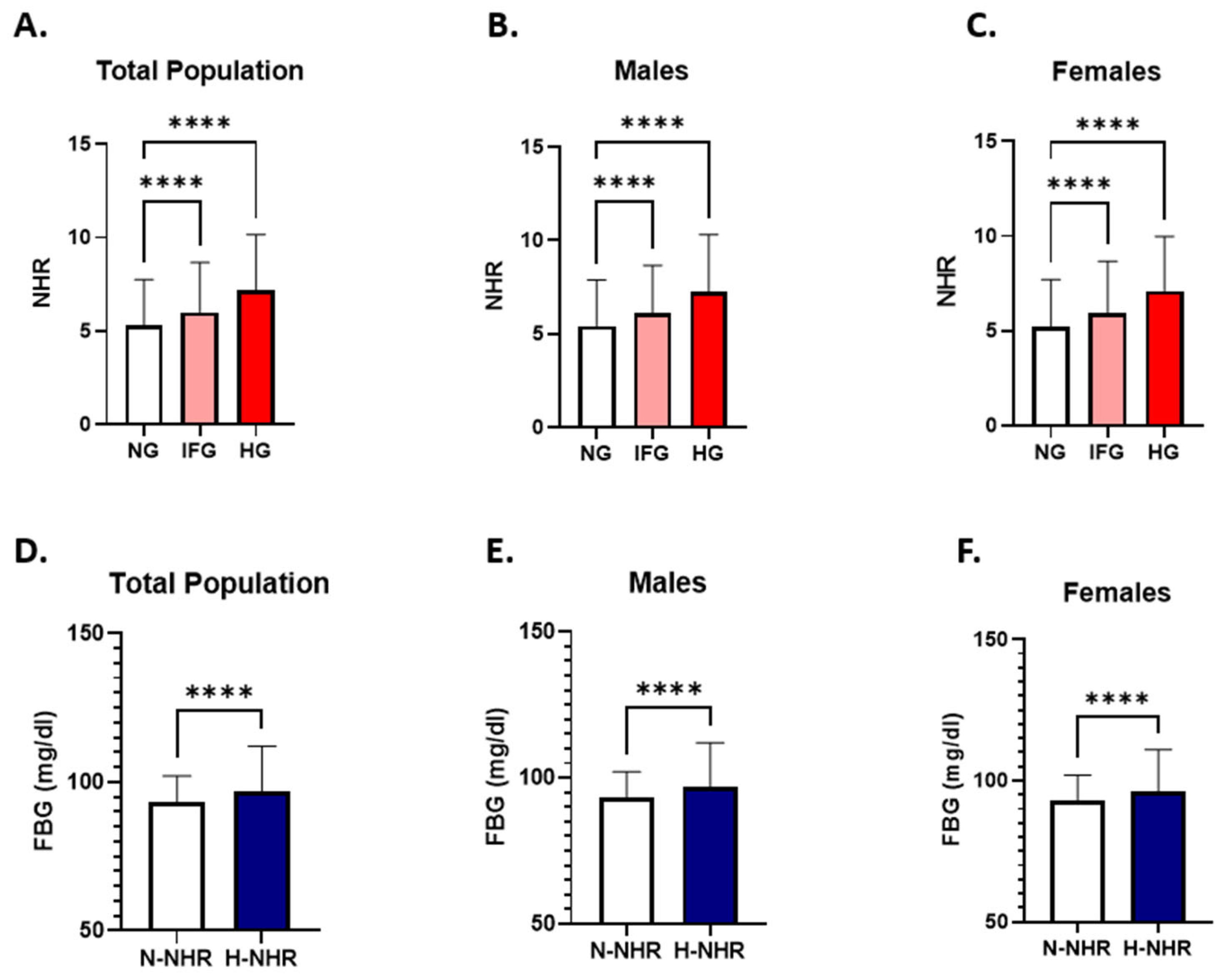
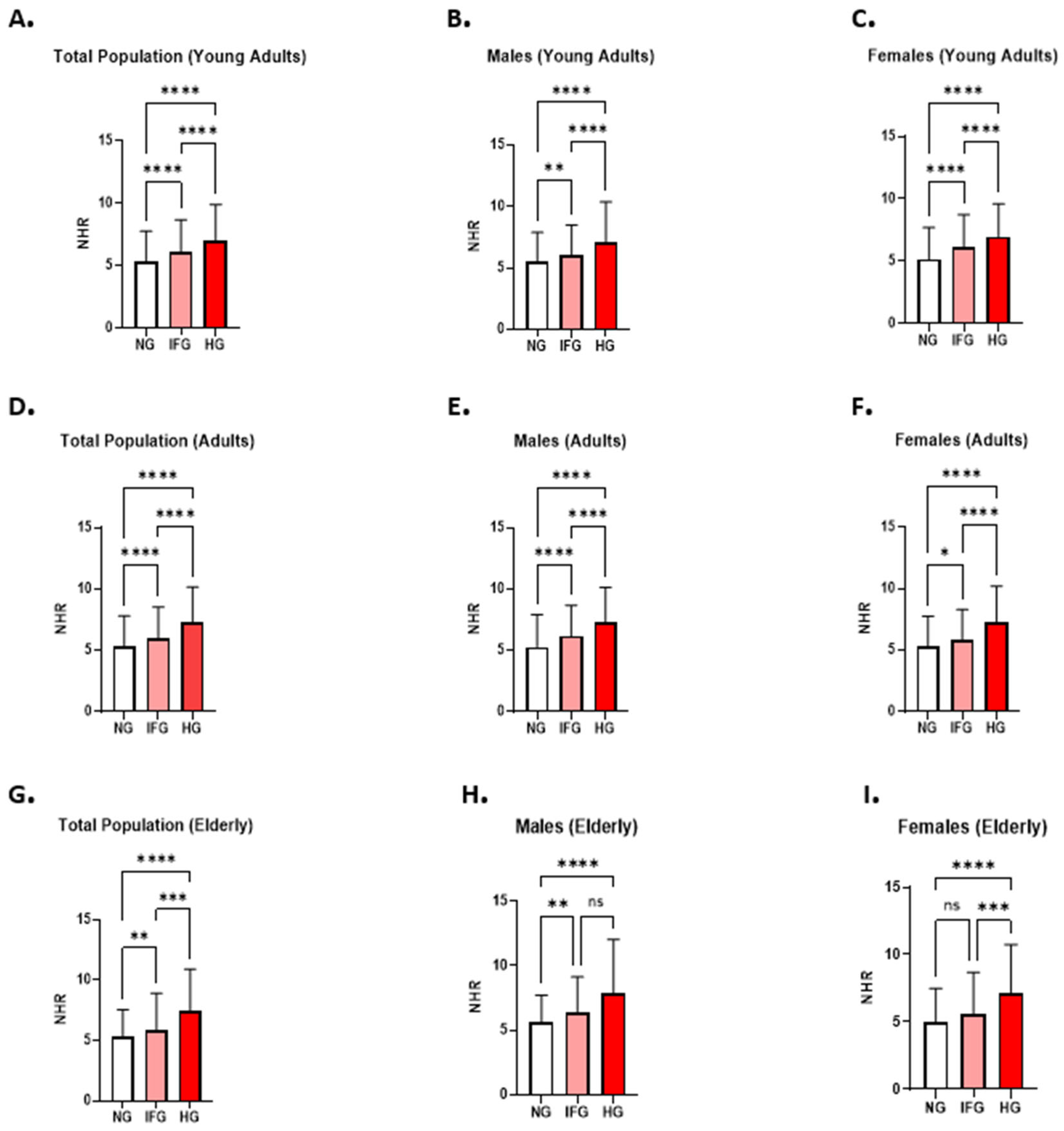
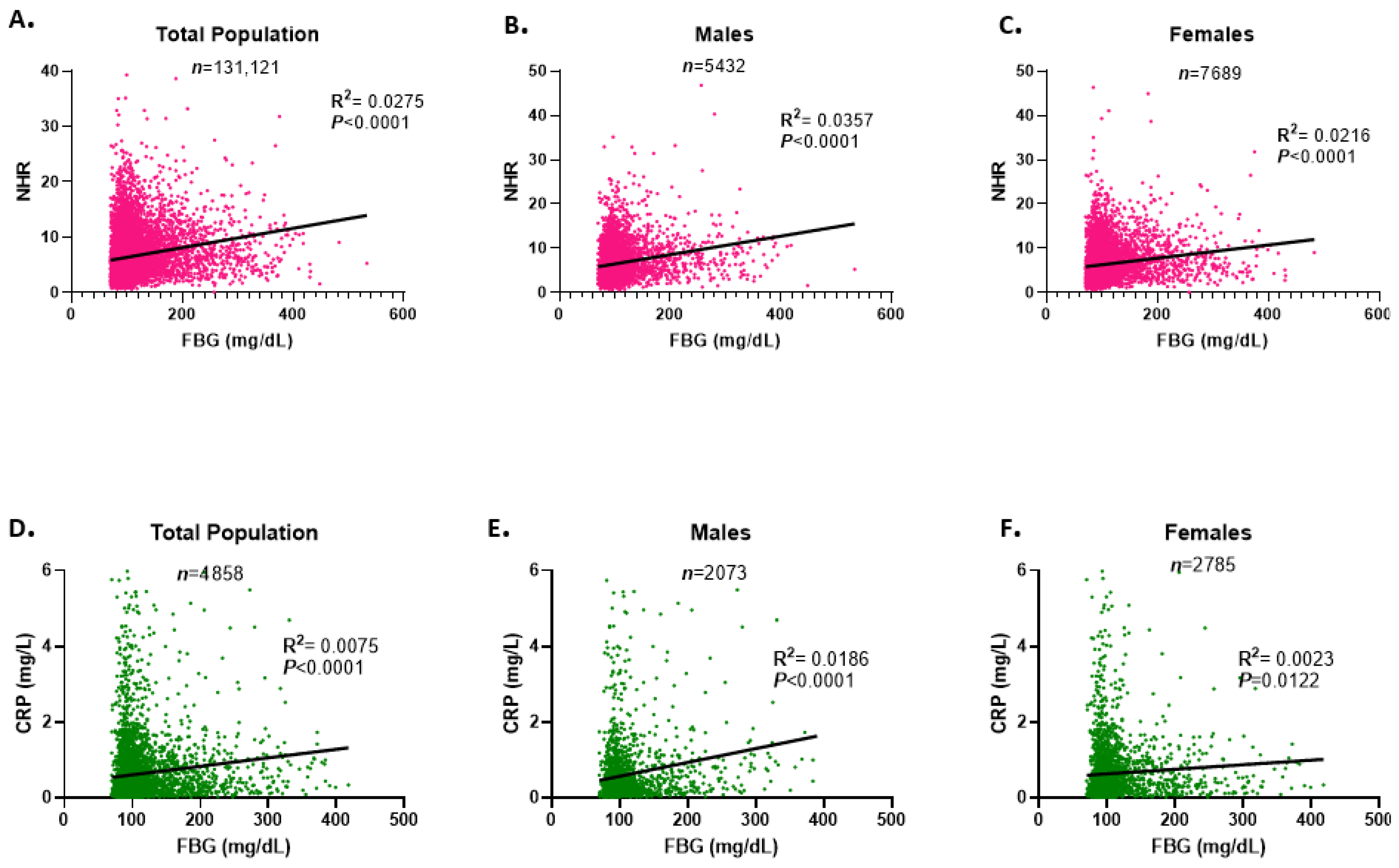
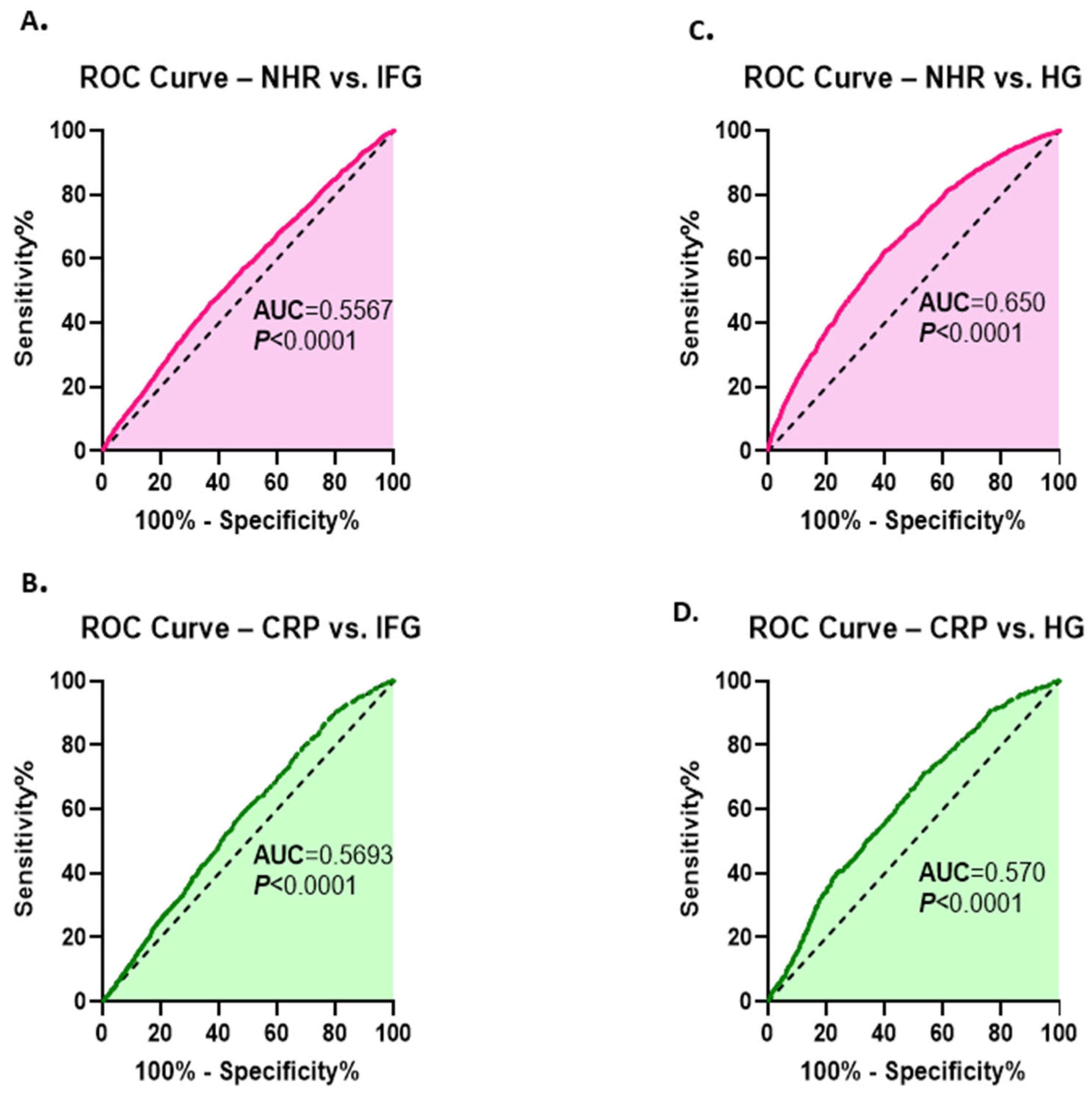

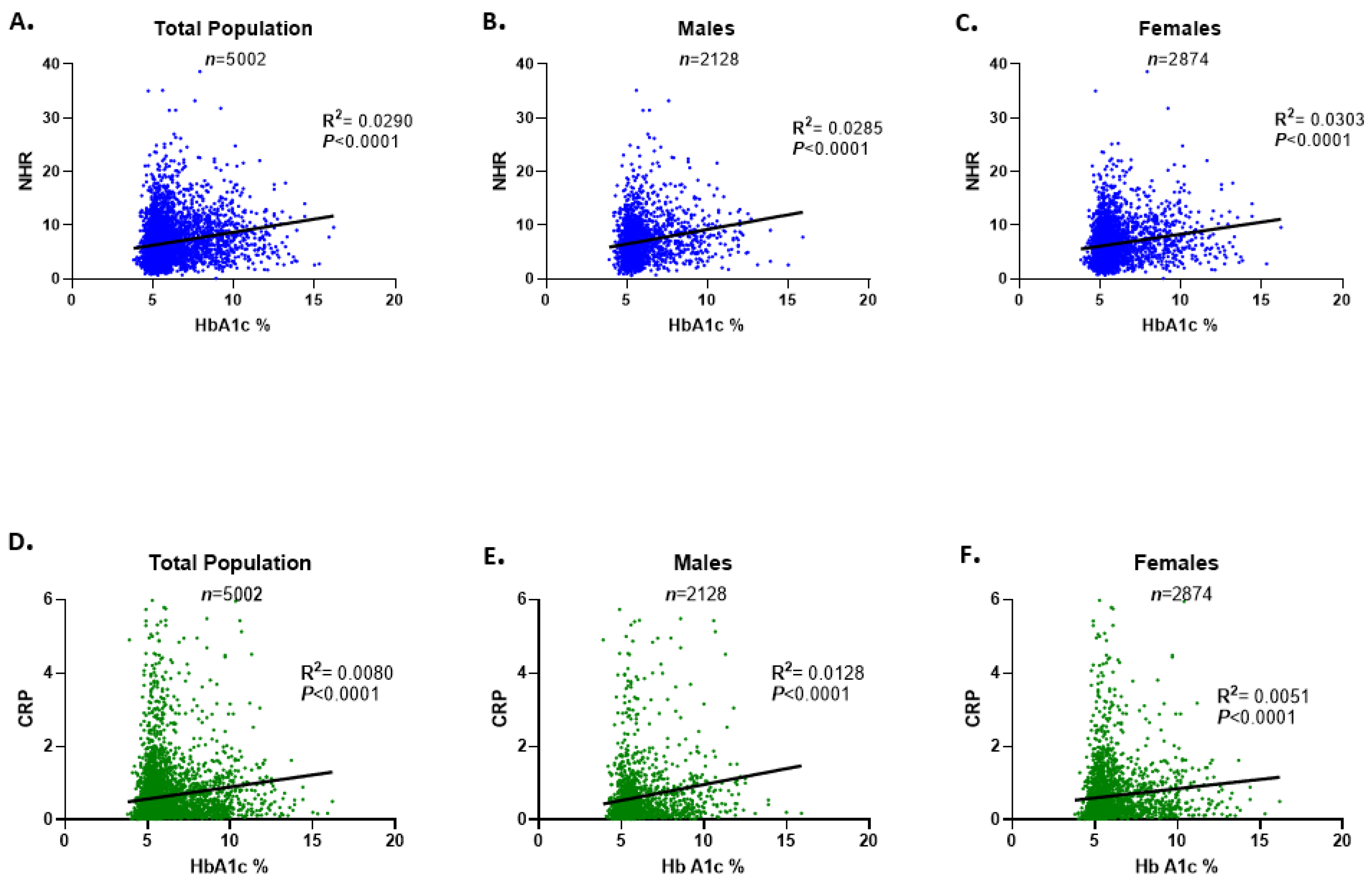
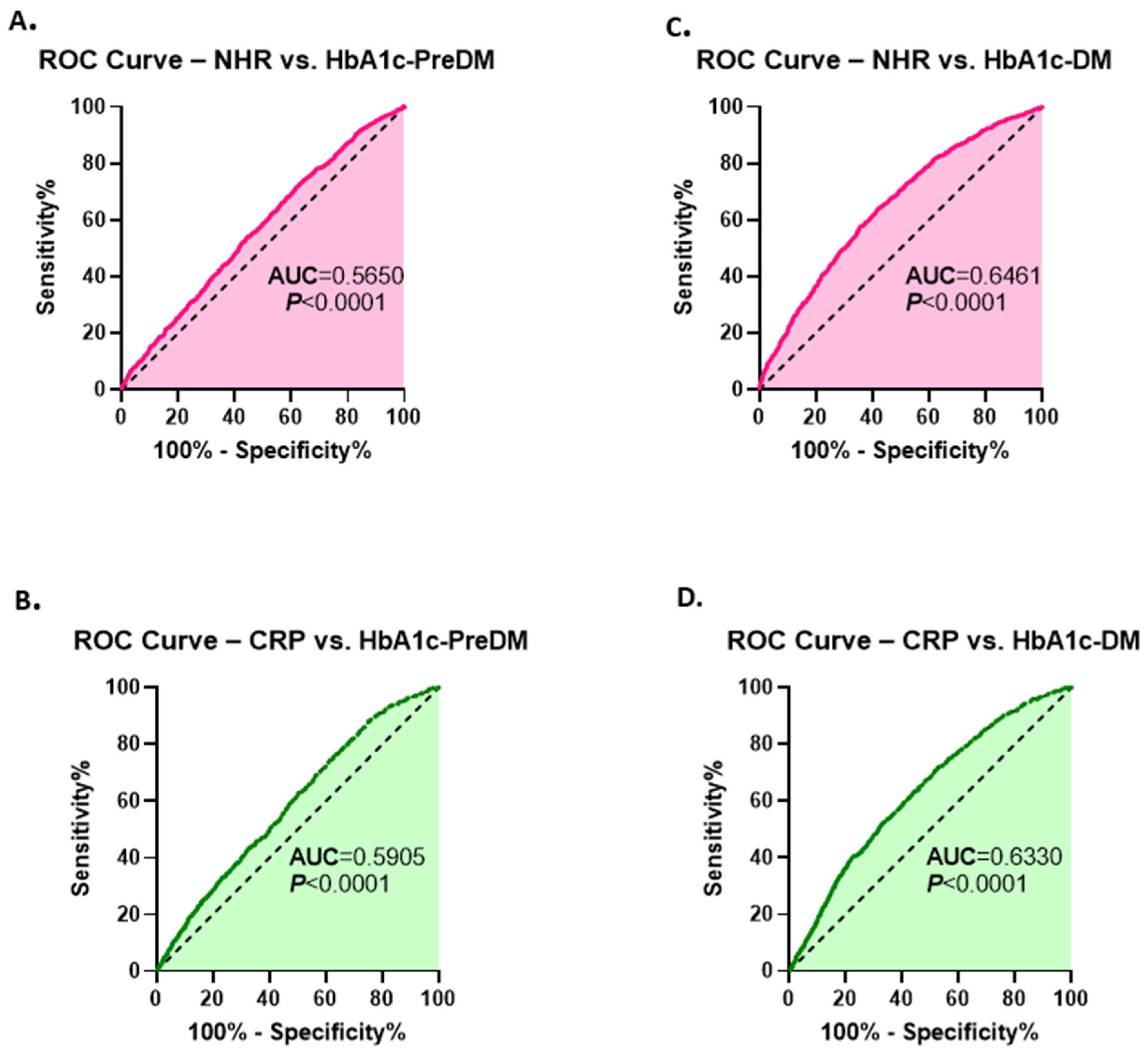
| Characteristic | NG Group | IFG Group | HG Group | p-Value |
|---|---|---|---|---|
| Demographics | ||||
| Age (years) | 39 (33–50) | 40 (34–52) | 41 (34–57) | <0.0001 |
| Males, n (%) | 3402 (25.93%) | 1316 (10.03%) | 714 (5.44%) | - |
| Female, n (%) | 4947 (37.70%) | 1785 (13.60%) | 957 (7.29%) | - |
| Lab parameters | ||||
| Free T4 (ng/dL) | 1 (0.92–1.09) | 0.99 (0.91–1.08) | 1 (0.92–1.11) | <0.0001 |
| TSH (mIU/L) | 1.76 (1.17–2.70) | 1.82 (1.19–2.79) | 1.85 (1.18–2.78) | 0.0611 |
| ALT (U/L) | 17 (13–26) | 22 (15–31) | 22 (16–32) | <0.0001 |
| AST (U/L) | 18 (15–23) | 19 (16–24) | 18 (15–24) | <0.0001 |
| Hemoglobin (g/dL) | 14.10 (12.9–15.50) | 14.70 (13.30–15.90) | 14.80 (13.50–15.90) | <0.0001 |
| Chloride (mEq/L) | 105 (103–107) | 105 (102–107) | 102 (100–105) | <0.0001 |
| Calcium (mg/dL) | 9.60 (9.30–9.90) | 9.60 (9.30–9.90) | 9.60 (9.30–9.90) | 0.09 |
| Total Bilirubin (mg/dL) | 0.56 (0.40–0.78) | 0.54 (0.93–0.74) | 0.5 (0.38–0.69) | <0.0001 |
| Parameter | NG | IFG | HG |
|---|---|---|---|
| Both genders | |||
| N-NHR | 56.44% | 45.44% | 35.25% |
| H-NHR | 43.56% | 51.98% | 64.75% |
| Males | |||
| N-NHR | 54.85% | 46.66% | 33.75% |
| H-NHR | 45.15% | 53.34% | 66.25% |
| Females | |||
| N-NHR | 57.53% | 49.02% | 36.36% |
| H-NHR | 42.47% | 50.98% | 63.64% |
| Score | 95% CI | Z Statistic | Significance Level | ||
|---|---|---|---|---|---|
| PR | |||||
| Both genders | 1.2249 | 1.1753–1.2766 | 9.622 | p < 0.0001 | |
| Males | 1.1815 | 1.1097–1.2579 | 5.217 | p < 0.0001 | |
| Females | 1.2004 | 1.1352–1.2694 | 6.407 | p < 0.0001 | |
| IFG | OR | ||||
| Both genders | 1.4822 | 1.3634–1.6114 | 9.232 | p < 0.0001 | |
| Males | 1.389 | 1.2225–1.5780 | 5.046 | p < 0.0001 | |
| Females | 1.4088 | 1.2638–1.5704 | 6.186 | p < 0.0001 | |
| PR | |||||
| Both genders | 1.4864 | 1.4239–1.5517 | 18.074 | p < 0.0001 | |
| Males | 1.4673 | 1.3761–1.5644 | 11.717 | p < 0.0001 | |
| Females | 1.4984 | 1.4142–1.5876 | 13.703 | p < 0.0001 | |
| HG | OR | ||||
| Both genders | 2.38 | 2.1336–2.6548 | 15.55 | p < 0.0001 | |
| Males | 2.6851 | 2.2540–3.1987 | 11.061 | p < 0.0001 | |
| Females | 2.3705 | 2.0541–2.7357 | 11.808 | p < 0.0001 |
| Marker | Model | Estimate | 95% CI | p-Value |
|---|---|---|---|---|
| FBG (mg/dL) | Unadjusted | 0.01745 | 0.01567–0.01922 | <0.0001 |
| Adjusted | 0.01733 | 0.01555–0.01910 | <0.0001 | |
| HbA1c % | Unadjusted | 0.4871 | 0.4090 to 0.5653 | <0.0001 |
| Adjusted | 0.481 | 0.4025 to 0.5595 | <0.0001 |
Disclaimer/Publisher’s Note: The statements, opinions and data contained in all publications are solely those of the individual author(s) and contributor(s) and not of MDPI and/or the editor(s). MDPI and/or the editor(s) disclaim responsibility for any injury to people or property resulting from any ideas, methods, instructions or products referred to in the content. |
© 2025 by the authors. Licensee MDPI, Basel, Switzerland. This article is an open access article distributed under the terms and conditions of the Creative Commons Attribution (CC BY) license (https://creativecommons.org/licenses/by/4.0/).
Share and Cite
Almuqrin, A.M.; Alrezaihi, A.F.; Aljasser, A.A.; Alqarni, I.; Alshuweishi, Y.; Alfhili, M.A. Association Between Neutrophil-to-HDL Ratio and Full-Spectrum Dysglycemia: Insights from a Large Middle Eastern Population Study. Healthcare 2025, 13, 3021. https://doi.org/10.3390/healthcare13233021
Almuqrin AM, Alrezaihi AF, Aljasser AA, Alqarni I, Alshuweishi Y, Alfhili MA. Association Between Neutrophil-to-HDL Ratio and Full-Spectrum Dysglycemia: Insights from a Large Middle Eastern Population Study. Healthcare. 2025; 13(23):3021. https://doi.org/10.3390/healthcare13233021
Chicago/Turabian StyleAlmuqrin, Abdulaziz M., Abdulrahman F. Alrezaihi, Ali A. Aljasser, Ibrahim Alqarni, Yazeed Alshuweishi, and Mohammad A. Alfhili. 2025. "Association Between Neutrophil-to-HDL Ratio and Full-Spectrum Dysglycemia: Insights from a Large Middle Eastern Population Study" Healthcare 13, no. 23: 3021. https://doi.org/10.3390/healthcare13233021
APA StyleAlmuqrin, A. M., Alrezaihi, A. F., Aljasser, A. A., Alqarni, I., Alshuweishi, Y., & Alfhili, M. A. (2025). Association Between Neutrophil-to-HDL Ratio and Full-Spectrum Dysglycemia: Insights from a Large Middle Eastern Population Study. Healthcare, 13(23), 3021. https://doi.org/10.3390/healthcare13233021







